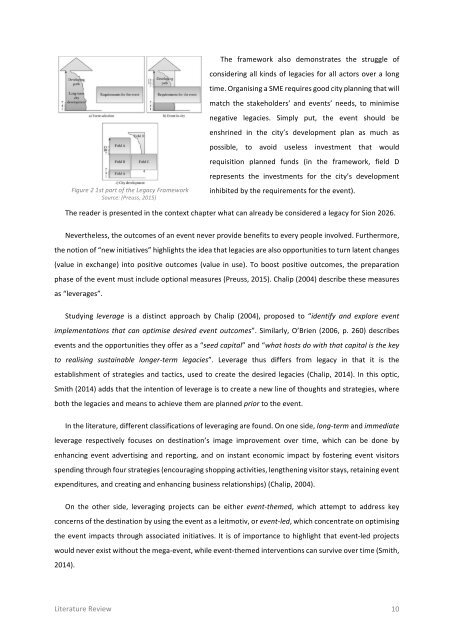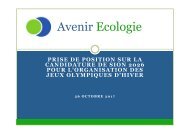Reviving the Flame
Travail de Master de Tiffany Duc
Travail de Master de Tiffany Duc
You also want an ePaper? Increase the reach of your titles
YUMPU automatically turns print PDFs into web optimized ePapers that Google loves.
The framework also demonstrates <strong>the</strong> struggle of<br />
considering all kinds of legacies for all actors over a long<br />
time. Organising a SME requires good city planning that will<br />
match <strong>the</strong> stakeholders’ and events’ needs, to minimise<br />
negative legacies. Simply put, <strong>the</strong> event should be<br />
enshrined in <strong>the</strong> city’s development plan as much as<br />
possible, to avoid useless investment that would<br />
requisition planned funds (in <strong>the</strong> framework, field D<br />
represents <strong>the</strong> investments for <strong>the</strong> city’s development<br />
Figure 2 1st part of <strong>the</strong> Legacy Framework<br />
Source: (Preuss, 2015)<br />
inhibited by <strong>the</strong> requirements for <strong>the</strong> event).<br />
The reader is presented in <strong>the</strong> context chapter what can already be considered a legacy for Sion 2026.<br />
Never<strong>the</strong>less, <strong>the</strong> outcomes of an event never provide benefits to every people involved. Fur<strong>the</strong>rmore,<br />
<strong>the</strong> notion of “new initiatives” highlights <strong>the</strong> idea that legacies are also opportunities to turn latent changes<br />
(value in exchange) into positive outcomes (value in use). To boost positive outcomes, <strong>the</strong> preparation<br />
phase of <strong>the</strong> event must include optional measures (Preuss, 2015). Chalip (2004) describe <strong>the</strong>se measures<br />
as “leverages”.<br />
Studying leverage is a distinct approach by Chalip (2004), proposed to “identify and explore event<br />
implementations that can optimise desired event outcomes”. Similarly, O’Brien (2006, p. 260) describes<br />
events and <strong>the</strong> opportunities <strong>the</strong>y offer as a “seed capital” and “what hosts do with that capital is <strong>the</strong> key<br />
to realising sustainable longer-term legacies”. Leverage thus differs from legacy in that it is <strong>the</strong><br />
establishment of strategies and tactics, used to create <strong>the</strong> desired legacies (Chalip, 2014). In this optic,<br />
Smith (2014) adds that <strong>the</strong> intention of leverage is to create a new line of thoughts and strategies, where<br />
both <strong>the</strong> legacies and means to achieve <strong>the</strong>m are planned prior to <strong>the</strong> event.<br />
In <strong>the</strong> literature, different classifications of leveraging are found. On one side, long-term and immediate<br />
leverage respectively focuses on destination’s image improvement over time, which can be done by<br />
enhancing event advertising and reporting, and on instant economic impact by fostering event visitors<br />
spending through four strategies (encouraging shopping activities, leng<strong>the</strong>ning visitor stays, retaining event<br />
expenditures, and creating and enhancing business relationships) (Chalip, 2004).<br />
On <strong>the</strong> o<strong>the</strong>r side, leveraging projects can be ei<strong>the</strong>r event-<strong>the</strong>med, which attempt to address key<br />
concerns of <strong>the</strong> destination by using <strong>the</strong> event as a leitmotiv, or event-led, which concentrate on optimising<br />
<strong>the</strong> event impacts through associated initiatives. It is of importance to highlight that event-led projects<br />
would never exist without <strong>the</strong> mega-event, while event-<strong>the</strong>med interventions can survive over time (Smith,<br />
2014).<br />
Literature Review 10





